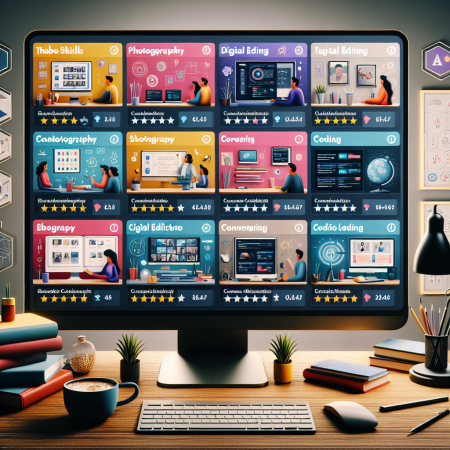How To Design an Online Course That Delivers Tangible Skills
Identify Your Target Audience
Understanding Their Needs
When I first started out, I thought I could create a course on a broad topic that would appeal to everyone. Boy, was I wrong! The more I learned, the clearer it became that knowing your audience is absolutely crucial. What are their pain points? What skills are they dying to acquire? By crafting detailed personas, you can target your content effectively.
For instance, if your audience consists of marketing professionals, gather insights into their daily challenges. Do they struggle with social media analytics, or are they more interested in content creation? Research and feedback can guide you here; it’s not so much guesswork once you tap into their minds!
Ultimately, when you understand who you’re speaking to, you can tailor your lessons to provide the skills and knowledge that speak directly to them. This connection makes for an inspired learning journey that’ll keep them coming back for more.
Create Clear Learning Objectives
Setting Specific Goals
One of the most vital lessons I learned was the power of clear learning objectives. Without them, a course can feel like a meandering road trip without a destination. Each module should have defined outcomes so that learners know what they should be able to do by the end of it.
For instance, instead of saying “learn social media marketing,” try “create an effective Instagram marketing strategy by the end of this module.” This specificity fuels motivation and informs your teaching approach, ensuring that learners grasp the tangible skills they’re honing.
Additionally, make sure these objectives are achievable. Stretching minds is great, but too much too fast can overwhelm, and nobody wants that. Clear, attainable objectives help keep everyone on the right track.
Design Engaging Content
Mix Up Your Formats
Once you’ve figured out your audience and objectives, it’s time to get creative! I found that an engaging mix of formats keeps learners interested and helps different styles of learners grasp concepts better. Think videos, quizzes, discussions, and interactive content – using various delivery methods is key.
For example, when I created a module on public speaking, I included video demonstrations, a reading list, and even a forum discussion for peer feedback. This kept the content dynamic and appealing, which in turn drove home those tangible skills.
Remember, too much of one thing can be a drag (ain’t nobody got time for that!). Keep the energy up and make your content visually appealing. The right graphics and clear layouts will have them glued to their screens!
Incorporate Practical Exercises
Hands-On Learning
One of the best parts of creating an online course is the ability to incorporate hands-on exercises. I learned this the hard way: content-heavy courses don’t resonate as well as those that balance instruction with practical applications. That’s where students can put what they’ve learned to the test!
Consider creating real-world scenarios for your learners to engage in – these could be case studies, projects, or even simulations. For my course on digital marketing, I had students develop a mock ad campaign, allowing them to apply their knowledge in a practical way while building confidence in their skills.
The takeaway here is that people learn by doing, not just by watching or reading. Make it about practice instead of just theory, and you’ll see the difference in their skillsets.
Provide Continuous Feedback and Support
Encouraging Growth
Feedback can make or break the learning experience. Early in my course development, I understood that learners need ongoing support to feel encouraged and engaged. Don’t just drop content and disappear; be there for your students!
This could mean giving personalized feedback on assignments or creating opportunities for peer reviews. I’ve found that fostering a supportive community can make a huge difference. One way to do this is by creating a space for discussions—whether that’s a forum, a chat group, or live Q&A sessions.
Continuous feedback also allows learners to adjust their paths as they progress. It helps them recognize their strengths and areas for improvement. This ongoing dialogue is what turns the course experience from passive into interactive and impactful!
Frequently Asked Questions
What type of audience should I focus on for my course?
Focusing on a specific audience helps tailor the course content to meet their needs effectively. Research their interests, struggles, and skill levels to create relevant material.
How do I set effective learning objectives?
Your learning objectives should be specific, measurable, attainable, relevant, and time-bound (SMART). Clearly defined goals help learners understand what to expect and strive for throughout the course.
What if my content is too complex for learners?
Simplify your material by breaking it down into digestible pieces. Incorporate practical examples and exercises to help learners grasp complex concepts and build their skills gradually.
How can I ensure my course is engaging?
Use a variety of content formats (e.g., videos, quizzes, discussions) and ensure your visuals are appealing. Keep things dynamic and relevant to maintain learner interest throughout the course.
What is the best way to provide feedback?
Offer constructive and timely feedback. Create opportunities for peer assessments and encourage open communication to foster a supportive learning environment. Continuous feedback keeps learners motivated!
Related Content
- The Benefits of Integrating Offline and Online Marketing Strategies
- How to Use Newsletters to Turn Leads Into Loyal Customers
- How to Transition from a Job to Full-Time Coaching Business
- Equip customers with knowledge-based resources that empower informed decision-making
- How to Find Your Niche and Build a Coaching Business Around It


